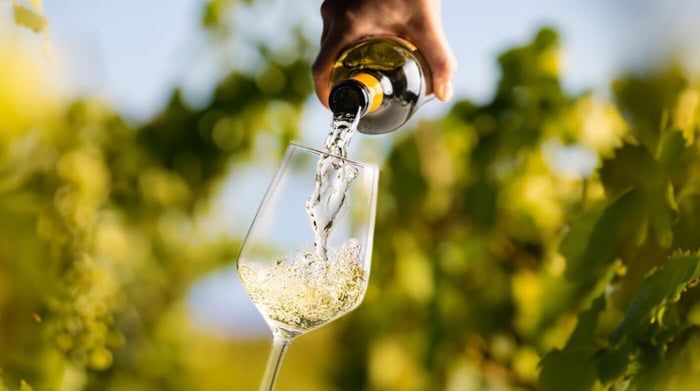Whilst we don’t specialise in wine recipes, we have created a rough guide to get you started if you're looking to make your own wine.
Firstly, when making your own white wine recipe using fresh fruit you need to ensure the right yeast is chosen. We would recommend CY17, BV7, or even CL23 – the latter two are known as ‘killer positive’ or killer active strains, meaning they are a safe bet for a beginner using fresh fruit as these yeasts will kill off any wild yeasts that may not have been removed during the cleaning stage.
CL23 is a ‘prise de mouse’ stile bayanus strain of yeast and is extremely robust, so this could be a good safe choice for a first-time winemaker.
White Wine Recipe
Ingredients:
To make approx. 20 L of wine you may need the following ingredients:
- 10-20+ kg grapes*
- Up to 4 kg white table sugar (sucrose)**
- Wine yeast
- Yeast nutrient
- Fining agent(s) to clarify the wine before bottling
*1 kg of grapes should provide roughly 1 L of grape juice after pressing, so > 20 kg would be required to produce 20 L of juice (accounting for wastage) – also, there will be some loss during winemaking, so perhaps around 25 kg grapes would be required to product 20 L of wine?
**If using 100 % grape juice then no sugar will be required, but if using less grape juice then sugar will be required to boost the alcohol level in the final wine (note that a specific gravity of 1.070 will be required to achieve around 10 % ABV and that each addition 1 % ABV requires around 7.5 gravity points – also that 1 kg sugar in 20 L total volume will give around 19 gravity points).
Note that in some cases an acid may also be required to adjust the grape juice must to the right level of acidity (especially if using a mixture of grape juice and white sugar) – if absence of specialised equipment, the adjustment can be made by taste (i.e. if the juice tastes insipid, add acid such as tartaric acid until it has a pleasing level of acidity).
pH is also relevant, especially if adding acid to the juice – We would recommend buying a roll of pH indicator paper online and making sure the pH of the juice must is between pH 3 and 4 (ideally 3.2-3.4). Alkaline acidity regulators such as Trisodium Citrate can be used to increase the pH if it is too low.
Equipment List:
- Fermentation vessel/bucket (minimum 23 Litre capacity) – note that having two can be a big advantage.
- Lid for fermentation vessel (with a hole and grommet for fitting of the airlock)
- Airlock
- Siphon kit (with sediment trap)
- Hydrometer
- Thermometer
- Mixing Paddle
- Steriliser (to sterilise your equipment before use)
Here are some rough guide instructions that will hopefully get things started but note that the internet is full of useful information and methods on how to make homemade wine.
The basic process for making your wine:
- Clean and sanitise your fermentation vessel, lid, grommet, airlock and mixing paddle.
- Sort your ripened grapes, discarding any bruised, unripe, overripe or damaged grapes, along with stalks etc.
- Wash your grapes 4 times under running water, making sure they are very clean before placing them in a clean and sanitized area to dry.
- If using sugar, dissolve this in water at around 20 C in the fermentation vessel (2 L water per 1 kg sugar should be sufficient).
- In a separate clean and sanitised vessel (note: avoid metal unless stainless steel), crush the grapes to allow the juice to be separated from the skins, then add grapes to the sugar-water mixture.
- Alternatively, if using 100 % grape juice you may wish to press the grapes to separate the juice before transferring the juice to your fermentation vessel (note that for red wines the skins must be left in contact with the juice for some time to extract colour from the skins).
- Taste the grape juice must to check the acidity, adjust if necessary (see notes above) and also check the pH and adjust if necessary.
- You may also wish to check the specific gravity, noting that a starting gravity of around 1.070 will yield approx. 10 % ABV; extra sugar can be added if necessary but note that gravity and acidity should be balanced.
- Transfer the juice to your fermentation vessel and sprinkle the yeast into the surface (there is no need to stir). You may wish to add yeast nutrient for peace of mind – if so, this should be stirred in well to dissolve.
- Fasten the lid onto the fermenter, half filling the airlock with (pre-boiled) water before leaving to ferment at 18-24 C (or according to the optimum temperature/range for yeast selected).
- Monitor closely during fermentation, stirring in any significant foaming/frothing if observed (ensure the equipment is sanitised accordingly before doing this). Then after around a week you should transfer to another sterilised vessel while sieving or straining off the grape skins (which can be discarded).
- If necessary, transfer the wine back to a fermentation vessel which has a lid and airlock, then leave it to continue fermenting.
- Once fermentation has completed (e.g. gravity on the hydrometer has stabilised and/or airlock has stopped bubbling and the wine tastes dry), you are now ready to stabilise and clarify your wine ahead of bottling.
- Rack the wine to another vessel, leaving behind any heavy yeast sediment, then preserve/stabilise with a suitable sulphite/sorbate mix (e.g. 3 g sodium metabisulphite and 4 g potassium sorbate per 20 L of wine – the latter is very important if producing a sweet wine).
- Stir very well to degas through before adding fining agents to clary the wine (e.g. kieselsol and chitosan) then leave to clear until completely bright before bottling.
- Once completely bright (note that bottling when not completely bright may result in sediment forming in the bottles) transfer to bottles (ideally green wine bottles) and seal well.
- Store your bottled wine in a cool dark place for as long as possible to age and mature before serving (we recommend a minimum of 1 month, but the wine should continue to improve for up to 6 months or more).
Please note this method is just a rough guide and there is certainly room for improvement/ You can develop the recipe through experience/trial and error or by researching the subject further online.
Also note that if you wish to produce a sweet wine, as a beginner it is much easier to make it sweeter with added sugar after the wine has fermented to dryness (retaining sweetness from the grape juice is quite tricky to do and not recommended for beginners). Sugar can be added to taste either with the fining agents (note that good stabilisation/preservation is essential here to prevent further fermentation!) or it can be added after a further racking of the bright wine before finally transferring to bottles.
Here are some suggested links for further reading, but there will likely be many more available online if wishing to research the subject further:
https://www.almostoffgrid.com/blogs/almost-off-grid/making-wine-from-garden-grapes
https://www.bigoven.com/recipe/homemade-grape-wine-recipe/1485097
https://www.pachakam.com/recipes/home-made-grape-wine




